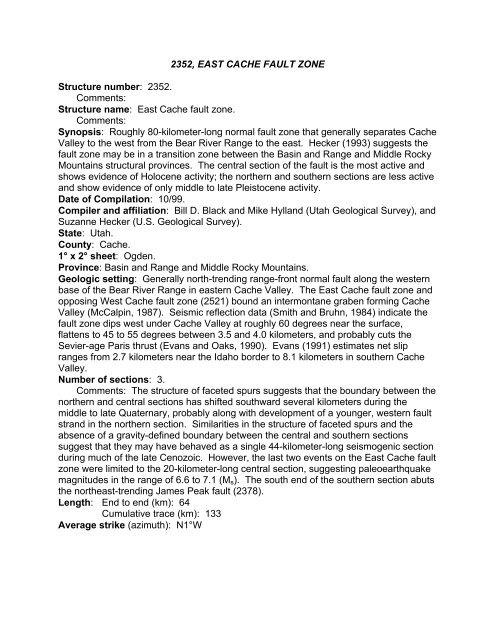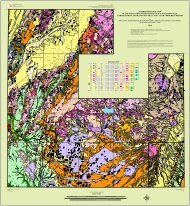2352, EAST CACHE FAULT ZONE - Utah Geological Survey
2352, EAST CACHE FAULT ZONE - Utah Geological Survey
2352, EAST CACHE FAULT ZONE - Utah Geological Survey
You also want an ePaper? Increase the reach of your titles
YUMPU automatically turns print PDFs into web optimized ePapers that Google loves.
<strong>2352</strong>, <strong>EAST</strong> <strong>CACHE</strong> <strong>FAULT</strong> <strong>ZONE</strong>Structure number: <strong>2352</strong>.Comments:Structure name: East Cache fault zone.Comments:Synopsis: Roughly 80-kilometer-long normal fault zone that generally separates CacheValley to the west from the Bear River Range to the east. Hecker (1993) suggests thefault zone may be in a transition zone between the Basin and Range and Middle RockyMountains structural provinces. The central section of the fault is the most active andshows evidence of Holocene activity; the northern and southern sections are less activeand show evidence of only middle to late Pleistocene activity.Date of Compilation: 10/99.Compiler and affiliation: Bill D. Black and Mike Hylland (<strong>Utah</strong> <strong>Geological</strong> <strong>Survey</strong>), andSuzanne Hecker (U.S. <strong>Geological</strong> <strong>Survey</strong>).State: <strong>Utah</strong>.County: Cache.1° x 2° sheet: Ogden.Province: Basin and Range and Middle Rocky Mountains.Geologic setting: Generally north-trending range-front normal fault along the westernbase of the Bear River Range in eastern Cache Valley. The East Cache fault zone andopposing West Cache fault zone (2521) bound an intermontane graben forming CacheValley (McCalpin, 1987). Seismic reflection data (Smith and Bruhn, 1984) indicate thefault zone dips west under Cache Valley at roughly 60 degrees near the surface,flattens to 45 to 55 degrees between 3.5 and 4.0 kilometers, and probably cuts theSevier-age Paris thrust (Evans and Oaks, 1990). Evans (1991) estimates net slipranges from 2.7 kilometers near the Idaho border to 8.1 kilometers in southern CacheValley.Number of sections: 3.Comments: The structure of faceted spurs suggests that the boundary between thenorthern and central sections has shifted southward several kilometers during themiddle to late Quaternary, probably along with development of a younger, western faultstrand in the northern section. Similarities in the structure of faceted spurs and theabsence of a gravity-defined boundary between the central and southern sectionssuggest that they may have behaved as a single 44-kilometer-long seismogenic sectionduring much of the late Cenozoic. However, the last two events on the East Cache faultzone were limited to the 20-kilometer-long central section, suggesting paleoearthquakemagnitudes in the range of 6.6 to 7.1 (M s ). The south end of the southern section abutsthe northeast-trending James Peak fault (2378).Length: End to end (km): 64Cumulative trace (km): 133Average strike (azimuth): N1°W
<strong>2352</strong>a, NORTHERN <strong>EAST</strong> <strong>CACHE</strong> SECTIONSection number: <strong>2352</strong>a.Section name: Northern East Cache section.Comments: Hecker's (1993) fault number 11-1.Reliability of location: Good.Comments: Mapping from McCalpin (1989). Bedrock outliers and geophysical dataindicate several concealed faults in Cache Valley west of the northern section. Theylack surface expression, so only the concealed fault displacing pre-Bonneville alluviumat one locality near Hyde Park (McCalpin, 1989) is shown on the map.Sense of movement: N.Comments:Dip: 40-60°W (Smith and Bruhn, 1984).Comments: Seismic reflection data indicate the fault dips at 60° near the surface,flattening at depth to 45-55° (Smith and Bruhn, 1984).Dip direction: W.Geomorphic expression: The fault section consists of two parallel, range-boundingfault strands roughly 3.5 kilometers apart, and one or two other strands concealedbeneath the valley floor to the west. Activity data are from alluvial surfaces with asmuch as 20 meters of surface displacement at the southern end of the younger, westernstrand. To the north, pediment surfaces rise 500 meters in elevation and are buried onthe downthrown side. The northward rise in pediment elevation and southwardsteepening of the main (eastern) range front suggests progressive transfer of slip fromthe eastern to the western strand. Tilted Bonneville shorelines in the vicinity of a largedelta are attributed to depositional loading onto weak Salt Lake Formation rocks andresulting ductile bending. At one location on the western strand, a graben in Provo-leveldeltaic deposits below unfaulted deltaic topset beds shows a total displacement of 0.4meters. The displacement appears to be localized and may be due to lateral spreadingrather than seismogenic faulting.Age of faulted deposits: Late Pleistocene.Paleoseismology studies: None.Timing of most recent paleoevent: (5) Quaternary (
Average strike (azimuth): N2°E<strong>2352</strong>b, CENTRAL <strong>EAST</strong> <strong>CACHE</strong> SECTIONSection number: <strong>2352</strong>b.Section name: Central East Cache section.Comments: Hecker's (1993) fault number 11-2.Reliability of location: Good.Comments: Mapping from McCalpin (1989).Sense of movement: N.Comments:Dip: 45-60°W (Smith and Bruhn, 1984); 65°W to near vertical (McCalpin, 1994).Comments: Seismic reflection data indicate the fault dips at 60 o near the surface,flattening at depth to 45-55° (Smith and Bruhn, 1984). At the Bonneville trench south ofLogan, McCalpin (1994) measured westward dips of 65-75° near the trench floor,steepening to near vertical at the surface.Dip direction: W.Geomorphic expression: Two post-Bonneville highstand surface-faulting earthquakeson the central section created composite fault scarps having up to 4.2 meters of surfaceoffset over a distance of at least 8 kilometers in its northern half. Measureddisplacements for the most recent event (0.5-1.2 meters) are less than the penultimateevent (1.4-1.9 meters). Unlike the northern and southern sections, the central section(which is composed of Paleozoic rocks) does not show evidence for post-Bonnevillewarping, attributed to depositional loading. This may be because faulting along thecentral section has decoupled the upthrown block from the loaded downthrown block.Inferred magnitudes for the most recent and penultimate surface-faulting earthquakesrange from M s 6.6 to 7.1.Age of faulted deposits: Holocene.Paleoseismology studies: Two trenches were excavated across the central section ofthe East Cache fault zone. The “Bonneville trench” (site <strong>2352</strong>b-2) was on the LakeBonneville-highstand delta 0.9 kilometers south of Logan Canyon, and exposedevidence for two surface-faulting earthquakes (McCalpin and Forman, 1991; McCalpin,1994). Within the main fault zone, quantitative pedogenic soil analysis,thermoluminescence age estimates on shallow lacustrine sand and silty colluvialdeposits, and an AMS radiocarbon age on gastropod shells within a beach-sand depositprovide limiting ages for the penultimate event and poorly constrain the timing of themost recent event. To better constrain the age of the later event, the ”Provo trench”(site <strong>2352</strong>b-1) was excavated about 1 kilometer north of the Bonneville trench, at theLogan Country Club golf course. This trench exposed stratigraphic evidence for themost recent surface-faulting event, and radiocarbon age estimates were obtained frombulk-soil samples of crack-fill material, debris-facies colluvium, and a paleosol beneaththe colluvium that more tightly constrain the age of this event (McCalpin, 1994).Timing of most recent paleoevent: (2) Latest Quaternary (
the penultimate earthquake event likely occurred between formation of the Bonnevilleand Provo shorelines, and radiocarbon and TL age estimates place it between 13 and15.5 ka. This event may have been influenced by loading from the water or deposits ofLake Bonneville. Equivocal evidence, based on a 1930s photo of a road cut whichshows a 4.9-meter displacement in prodelta sands, exists for another event between19.4 ka (approximately when the lake shore reached the site) and 15-17 ka.Recurrence interval: 9.0-11.5 ky (
Recurrence interval: 7.5-143 ky (
















